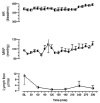Plasma appearance rate of intraperitoneal macromolecular tracer underestimates peritoneal lymph flow
- PMID: 18985995
- PMCID: PMC2596618
Plasma appearance rate of intraperitoneal macromolecular tracer underestimates peritoneal lymph flow
Abstract
The magnitude of peritoneal lymph flow is an issue of great controversy in peritoneal dialysis (PD) research. Because no single lymphatic duct drains the entire peritoneal cavity, peritoneal lymph flow is indirectly measured as lymphatic removal of intraperitoneal macromolecular tracer. In rats, the peritoneal clearance (K) of such a tracer is 5 times the approximately 8 microL/min determined from the tracer appearance rate in blood (Cl). The fractional contribution of tissues bordering the peritoneal cavity to the overall Cl was determined to be diaphragm, 55%; viscera, 30%; and abdominal wall, 15%. The present study determines whether direct measurement of visceral peritoneal lymph flow matches the 30% (approximately 2.5 microL/min) contribution of the visceral peritoneal lymph flow as measured indirectly by the Cl method. The mesenteric lymph duct that exclusively drains lymph from the gut, liver, and mesentery was cannulated in 15 rats, and lymph flow from the duct was collected at hourly intervals up to 6 hours under near-normal physiologic conditions and under conditions of simulated PD. Changes in mesenteric lymph flow that resulted from a challenge with 3 mL intravenous saline were captured using real-time video. We observed no significant differences between the hourly lymph volumes collected over 6 hours in naïve animals (n = 5, p > 0.05). Under conditions of simulated PD with dialysis fluid in the peritoneal cavity, the mesenteric duct lymph flow averaged 8.67 +/- 1.41 microL/min (n = 10). That flow is similar to reported data on total peritoneal Cl in rats; and 4 times the 2.5 microL/min visceral peritoneal contribution to the total peritoneal Cl. The intravenous saline challenge significantly increased mesenteric lymph duct output to 30.9 +/- 1.6 microL/min (n = 5, p < 0.01) and reduced the lymph-to-plasma concentration ratio (L/P) by 43%. The reflection coefficient for total proteins (sigma(prot)) across the intestinal capillaries as calculated from the filtration rate-dependent L/P ratio when the transcapillary fluid escape rate and the mesenteric lymph flow were both high was more than 0.87. We concluded that (A) under near-normal physiologic conditions, the mesenteric lymph duct flow is steady, but quite low; (B) under conditions of simulated PD, the mesenteric lymph duct flow increases significantly from the physiologic norm; (C) mesenteric lymph duct flow is sensitive to the peritoneal fill volume; (D) during simulated PD, the fractional visceral peritoneal lymph flow measured indirectly from plasma appearance of intraperitoneal tracer underestimates the directly measured mesenteric duct lymph flow; and (E) the increased transcapillary fluid escape rate is rapidly buffered by augmentation of mesenteric lymph duct output.
Figures



Similar articles
-
Clearance of tracer albumin from peritoneal cavity to plasma at low intraperitoneal volumes and hydrostatic pressures.Perit Dial Int. 1998 Sep-Oct;18(5):497-504. Perit Dial Int. 1998. PMID: 9848628
-
Quantitation of lymphatic drainage of the peritoneal cavity in sheep: comparison of direct cannulation techniques with indirect methods to estimate lymph flow.Perit Dial Int. 1993;13(4):270-9. Perit Dial Int. 1993. PMID: 8241327
-
Lymphatic drainage of the peritoneal space: a pattern dependent on bowel lymphatics.Ann Surg Oncol. 2007 Feb;14(2):286-98. doi: 10.1245/s10434-006-9044-6. Ann Surg Oncol. 2007. PMID: 17096058 Free PMC article.
-
Role of lymphatics in peritoneal dialysis.Blood Purif. 1992;10(3-4):163-72. doi: 10.1159/000170043. Blood Purif. 1992. PMID: 1308682 Review.
-
Pathways for fluid loss from the peritoneal cavity.Blood Purif. 1992;10(3-4):115-21. doi: 10.1159/000170038. Blood Purif. 1992. PMID: 1308677 Review.
Cited by
-
Peritoneal changes in patients on long-term peritoneal dialysis.Nat Rev Nephrol. 2013 Jul;9(7):419-29. doi: 10.1038/nrneph.2013.99. Epub 2013 May 14. Nat Rev Nephrol. 2013. PMID: 23670085 Review.
-
Measuring peritoneal absorption with the prolonged peritoneal equilibration test from 4 to 8 hours using various glucose concentrations.Perit Dial Int. 2014 Sep-Oct;34(6):605-11. doi: 10.3747/pdi.2013.00235. Perit Dial Int. 2014. PMID: 25228213 Free PMC article.
References
-
- Abernethy NJ, Chin W, Hay JB, Rodela H, Oreopoulos D, Johnston MG. Lymphatic drainage of the peritoneal cavity in sheep. Am J Physiol. 1991;260:F353–8. - PubMed
-
- Tran L, Rodela H, Hay JB, Oreopoulos D, Johnston MG. Quantitation of lymphatic drainage of the peritoneal cavity in sheep: comparison of direct cannulation techniques with indirect methods to estimate lymph flow. Perit Dial Int. 1993;13:270–9. - PubMed
-
- Tran L, Rodela H, Abernethy NJ, et al. Lymphatic drainage of hypertonic solution from peritoneal cavity of anesthetized and conscious sheep. J Appl Physiol. 1993;74:859–67. - PubMed
-
- Yuan Z, Rodela H, Hay JB, Oreopoulos D, Johnston MG. Lymph flow and lymphatic drainage of inflammatory cells from the peritoneal cavity in a casein-peritonitis model in sheep. Lymphology. 1994;27:114–28. - PubMed
-
- Flessner MF, Parker RJ, Sieber SM. Peritoneal lymphatic uptake of fibrinogen and erythrocytes in the rat. Am J Physiol. 1983;244:H89–96. - PubMed
Publication types
MeSH terms
Substances
Grants and funding
LinkOut - more resources
Full Text Sources

